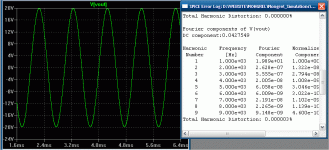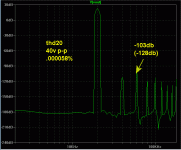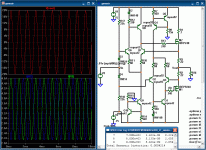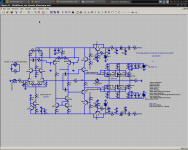I actually intend to have the answer to all this "flurry ,bluster,yammering".. 2 huge threads (277+731 posts) , many conflicting ego's.I am curious , but do not want to break the bank to develop better circuits. Unproven designs , group buys for circuits that are not even out of the R / D phase. 😕 Give me a break !!!
Trafo with one wire ... he he... 😱 Electrons are teleported to the amp. 😱
VOODOO!!
OS
Just a big ground pin at either end. 😀
You forgot the ACTIVE group buy thread, with some money down and quibbling over which parts to use on a board that is not been put to bed. BUT I think overall this ENTIRE aMp has been a good deal and given me at least a lot of joy watching and learning.
I am looking forward to listen to this threads amp as the walls shudder in sync with the woofers.
I am looking forward to listen to this threads amp as the walls shudder in sync with the woofers.
I do mean tuned...as to resonate in certain manners...
there is a reason why in tune is pretty much the same all over the world...that singing and instruments fit each other regardless of global location..
It seems like we as humans all share the same sense of what good is...there is simply certain harmonics we like and some we don't... size matters...I have tested amplifiers the same amplifiers..with the exact same circuit exact same layout...but fitted on different size circuit boards one longer and wider than the other (excess size just bare PCB)...they sounded totally different...one singing other dead in the water...The funny thing is that you could tell the difference simply by holding the boards..tapping and scratching them with your fingernails revealed one board full and pleasant sounding.. while the other was thin and without body...exactly this was also the signature of the amps when they were fired up....
This is not about induced or tapped microphonics.. but merely what happens when the amplifier is playing...the character of it's sound....
And OS.. get those isolation feet off..those are not mechanical grounding and does not provide an exit path for the signal induced vibration..so many things inside develops mechanical forces when the amplifier is playing...and large and small signals passes through circuits.. transformers humming, diodes switching capacitors charging and decharging...magnetic fields changing.. all this makes boards vibrate...and that is what we need exit paths for....otherwise the energy is stored inside the amplifier and that for sure deteriorates the sound...
there is a reason why in tune is pretty much the same all over the world...that singing and instruments fit each other regardless of global location..
It seems like we as humans all share the same sense of what good is...there is simply certain harmonics we like and some we don't... size matters...I have tested amplifiers the same amplifiers..with the exact same circuit exact same layout...but fitted on different size circuit boards one longer and wider than the other (excess size just bare PCB)...they sounded totally different...one singing other dead in the water...The funny thing is that you could tell the difference simply by holding the boards..tapping and scratching them with your fingernails revealed one board full and pleasant sounding.. while the other was thin and without body...exactly this was also the signature of the amps when they were fired up....
This is not about induced or tapped microphonics.. but merely what happens when the amplifier is playing...the character of it's sound....
And OS.. get those isolation feet off..those are not mechanical grounding and does not provide an exit path for the signal induced vibration..so many things inside develops mechanical forces when the amplifier is playing...and large and small signals passes through circuits.. transformers humming, diodes switching capacitors charging and decharging...magnetic fields changing.. all this makes boards vibrate...and that is what we need exit paths for....otherwise the energy is stored inside the amplifier and that for sure deteriorates the sound...
OS,
I see your results, pretty amazing but would cosider your VAS a darlington or a buffered cascode?
Great work by the way. 😎
Jam
Doug self describes it as a "beta enhancement emitter follower".In this case , it is applied to a balanced VAS (Self says there is "little to gain")here. I beg to differ as this "blows the blameless away" (Pix1). Definitely "vanilla' 😎
OS
Attachments
Last edited:
OS,
We are looking at 2nd harmonic at -158dB(v), that I would say is vanilla^2, it is probably 20dB below the noisefloor - how on earth did you manage that?
The next qualifying stage for an engineer is that of magician.
We are looking at 2nd harmonic at -158dB(v), that I would say is vanilla^2, it is probably 20dB below the noisefloor - how on earth did you manage that?
The next qualifying stage for an engineer is that of magician.

OS,
We are looking at 2nd harmonic at -158dB(v), that I would say is vanilla^2, it is probably 20dB below the noisefloor - how on earth did you manage that?
The next qualifying stage for an engineer is that of magician.
I am astounded , a simple amp that is PPM , my LT is not rigged... run it. It does quite well for THD20 as well.
Edit: consider this is the input/VAS in isolation as well.
OS
Attachments
Last edited:
If anything , it must thank Nagsy for triggering this. Check this out for 120V p-p THD20 - no way!! 😕 Have you checked the ELD revision 8 spec wise ?? Nico (AP distortion analyzer - etc.) It should be in the ballpark.
OS
Is this the performance of the full amp?
What bias are you running at?
My only advice here, is increase the bias to around 700mA and watch the higher order harmonics be transported to another dimension.😀
OS:
Which schematic is this?
Yeah Nagys
download this , Linear Technology - LTspice IV Downloads and Updates
, run my last .zip file attachment (post #284) in a folder.
The FET input version does almost as well.
With my NJW BJT's biased at 80mA each.
.001% 120v p-p THD20
.0004% 40v p-p THD20
145ppm 120v p-p 1k
37ppm 40v p-p 1k
Just hook feedback back to main OPS , Move "Vout" there ,too.
Adjust "R38" (rbias) to 125R = 81mA.
I would assume laterals would perform as well , depending on the virtue of their models.
OS
.001% 120v p-p THD20
.0004% 40v p-p THD20
145ppm 120v p-p 1k
37ppm 40v p-p 1k
Just hook feedback back to main OPS , Move "Vout" there ,too.
Adjust "R38" (rbias) to 125R = 81mA.
I would assume laterals would perform as well , depending on the virtue of their models.
OS
I've proven to myself that I can listen to anything and enjoy my music. Although sometimes hearing more details helps the emotional impact. This is my observation with orchestral pieces, where instrument separation must be very good or all the instruments blend into one boring glob. Solid bass helps too.
I think trying to remove all distortions is not that useful. Except perhaps phase distortion. Usually to me, whether or not I can tell where the drummer is doesn't affect my emotional response. However I think it would still be cool if my amp could reproduce the spatial information in the music exactly.
More to the point I think it depends on the music being played.
In any case, tube amps with 50% THD are reported to sound good, so apparently blanket THD doesn't matter so much. I think it is better to refine the distortions already present so that they are benign, and only reduce distortion if this can be preserved.
But then we have a problem. What kind of distortions are benign and which ones aren't? I suppose it might be easy to say high order distortions are one. How about we start with something we are sure about? Thoughts anyone?
- keantoken
I think trying to remove all distortions is not that useful. Except perhaps phase distortion. Usually to me, whether or not I can tell where the drummer is doesn't affect my emotional response. However I think it would still be cool if my amp could reproduce the spatial information in the music exactly.
More to the point I think it depends on the music being played.
In any case, tube amps with 50% THD are reported to sound good, so apparently blanket THD doesn't matter so much. I think it is better to refine the distortions already present so that they are benign, and only reduce distortion if this can be preserved.
But then we have a problem. What kind of distortions are benign and which ones aren't? I suppose it might be easy to say high order distortions are one. How about we start with something we are sure about? Thoughts anyone?
- keantoken
When I could clearly hear the sheer information, impact and tonal rightness of a Spectral DMA-260 I actually witnessed the guy we went together to listen to it ordering a tube amp over it. He said its ultimately ''solid state'' to me no matter how impressive, its the other one that relaxes me. Go figure. Anyway, each nature or topology thing you prefer or believe its right approach, each time you bring down its noise and THD by 6dB, its double linear and double cleaner. We can't perceive that directly under some threshold, but its an indication of a righter amp that we ultimately feel IMHO. Even through 1-3% THD speakers. In an ABX blind test we would mix a Pioneer receiver with a Halcro have no doubt though.
How about we start with something we are sure about? Thoughts anyone?
- keantoken
Here is a thought...
Should amplifiers be instruments themselves or should they act like transparent glass? Do we have measurements that can tell when an amplifier is acting like an instrument or like glass? Some say the ear is either a very unreliable measuring device or one of the most sophisticated measuring devices available.
No one is sure what the problem is, or how to measure it. This makes it difficult to know what the proper solution is.
No one is sure what the problem is, or how to measure it. This makes it difficult to know what the proper solution is.
best amps I have ever heard, and owned, always amps with relatively low output
never heard a big amp that was more than just ok
look around
theres several small and cheaper commercial amps braking the limit and getting fine reviews
but do we believe what we hear when we see a cheap and crappy looking design
I think its also a choise of whether you want to please your own ears, or impress your friends
in other words, I wouldnt go much higher than 100watt
but I wouldnt mind if it looked like 500watt

genesis , the $8000 "zero THD amp"
I did have the pleasure of listening for an extended period the mighty genesis stealth 200W class A. It did leave a "benchmark" in my head as well as allowing me to reverse engineer it's IRF power stage(below). At 4A class A dissipation per IRF240/9240 pair , it was the most fatigue free listening experience I have been exposed to. Upon investigating it with simulations , I found it to have distortions in the hundreds of PPM (.0003% or less). The voltage stage was a balanced VAS fed to a jensen 1:1 audio transformer.
So I have heard a VERY low distortion audiophile amp without the image being "swamped out" by H2/3. The soundstage and detail was exquisite , almost surreal ...... and this came from a amp with -110db second harmonic content. The Class A OPS could have me fooled with it's absence of crossover distortion but this too can be seen while simulating a typical BJT output stage. Underbias a BJT pair and the H3 will shoot "high to the sky".
A super low distortion amp will just highlight the goodness (or badness- low VBR mp3's) of it's source and allow the loudspeakers to sound as they are .. no more, no less.
OS
I did have the pleasure of listening for an extended period the mighty genesis stealth 200W class A. It did leave a "benchmark" in my head as well as allowing me to reverse engineer it's IRF power stage(below). At 4A class A dissipation per IRF240/9240 pair , it was the most fatigue free listening experience I have been exposed to. Upon investigating it with simulations , I found it to have distortions in the hundreds of PPM (.0003% or less). The voltage stage was a balanced VAS fed to a jensen 1:1 audio transformer.
So I have heard a VERY low distortion audiophile amp without the image being "swamped out" by H2/3. The soundstage and detail was exquisite , almost surreal ...... and this came from a amp with -110db second harmonic content. The Class A OPS could have me fooled with it's absence of crossover distortion but this too can be seen while simulating a typical BJT output stage. Underbias a BJT pair and the H3 will shoot "high to the sky".
A super low distortion amp will just highlight the goodness (or badness- low VBR mp3's) of it's source and allow the loudspeakers to sound as they are .. no more, no less.
OS
Attachments
A super low distortion amp will just highlight the goodness (or badness- low VBR mp3's) of it's source and allow the loudspeakers to sound as they are .. no more, no less.
OS
I hope not you mean that as a general rule
but why some amps(many) makes the music sound artificial, or why others dont(few), I really dont know
but the small MIRAND amp I have shines on any speaker
and surpricingly even into a really troubled and tough 2ohm Infinity 5way Kappa9
and its surpricingly easy to hear it
but how can it make such a speaker really sing
and even being severely under powered
that I would like to know
My experience indicates that different people hear differently. I believe it is a psychological phenomenon. For example, when a baby hears a violin, what does the baby think? Obviously between birth and now there has been a lot attention payed to the interpretation of sounds. This will vary between the psychologies of people. Take Salas' example. His friend want an amp to help him feel good. It seems Salas wants an amp that sounds transparent, and conveys the original, even if the original doesn't sound that great (am I close?).
In any case, this is off the beaten track. As some have pointed out, trying to IMPROVE the Goldmund isn't quite in spirit with this thread. It hardly needs improvement for the sound, it just needs a few tweaks to help with the stability and reliability.
While trying to improve it would definitely be exciting, and is worthy of endeavor with the amount of talent on this board, I think we should save this for after we've fixed the issues already present. I forgot what I had made this thread for.
Firstly - Stability
Who here knows how to make the amp more stable, hopefully just fiddling with the compensation capacitors? How do we make it more tolerant of unstable FETs?
I haven't had much time lately, unfortunately. I slept another 12 hours again and must go to bed soon.
- keantoken
In any case, this is off the beaten track. As some have pointed out, trying to IMPROVE the Goldmund isn't quite in spirit with this thread. It hardly needs improvement for the sound, it just needs a few tweaks to help with the stability and reliability.
While trying to improve it would definitely be exciting, and is worthy of endeavor with the amount of talent on this board, I think we should save this for after we've fixed the issues already present. I forgot what I had made this thread for.
Firstly - Stability
Who here knows how to make the amp more stable, hopefully just fiddling with the compensation capacitors? How do we make it more tolerant of unstable FETs?
I haven't had much time lately, unfortunately. I slept another 12 hours again and must go to bed soon.
- keantoken
Who here knows how to make the amp more stable, hopefully just fiddling with the compensation capacitors? How do we make it more tolerant of unstable FETs?
- keantoken
I dont know so much about these things
but it was suggested as a first step to lower output, and raise bias
sounded plausible to me
I dont know
but a big AB amp driven hard will dissipate like a classA amp
and bias cant pull it down
only the heatsinks will keep it safe
that could lead to thermal run away
no/yes ?
- Home
- Amplifiers
- Solid State
- Goldmund Mods, Improvements, Stability




